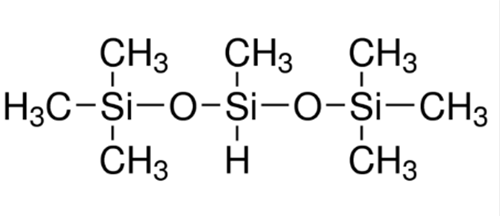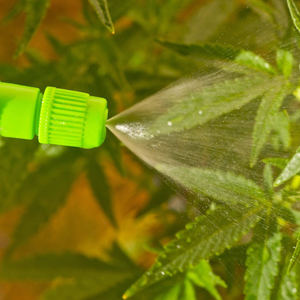XJY-703
Heptamethyltrisiloxane
PIONEER IN SILICONE RESIN
Agricultural surfactant is a substance that can significantly change the interface state of the solution system by adding a small amount. It has fixed hydrophilic and lipophilic groups, which can be aligned on the surface of the solution.

XJY-703 Heptamethyltrisiloxane contains an active Si-H group, which can replace the hydrogen-containing group with a polyether group to form XJY-207 Polyalkyleneoxide Modified Heptamethyltrisiloxane.
The polyether group of polyether-modified Heptamethyltrisiloxane has strong spreading surface modifying properties and can change the surface activity of the system.
In the pesticide system with polyether-modified Heptamethyltrisiloxane, the surface tension of polyether silicone oil can be reduced, so that pesticide droplets can spread on the surface of plants as soon as possible.
The spread of pesticides is conducive to the effect of the drugs in the system, and it also avoids failure on rainy days after a long time. At the same time, the molecular weight of XJY-207 Polyalkyleneoxide Modified Heptamethyltrisiloxane is small, which has little effect on the viscosity of the system and is also conducive to spraying.
The silicone agricultural surfactant has a skeleton composed entirely of methylated siloxanes, and one or more polyether segments are suspended from the skeleton. Skeletal silicon-oxygen bonds in siloxanes are susceptible to hydrolytic cleavage. The mechanism of its hydrolysis may be molecular rearrangement, the combination of two trisiloxane copolyalkanes into a tetrasiloxane copolymer and Hexamethyldisiloxane. The water solubility of tetrasiloxane is stronger than that of trisiloxane, while Hexamethyldisiloxane is water-insoluble silicone oil. The repeated reaction will greatly increase the content of polysiloxane copolymer. The surface activity is thus greatly reduced.

Silicone agricultural surfactants have an excellent spreading ability, which is a very important property in spraying operations. This may allow the surfactant to be easily adsorbed on the leading edge of the solution during the process of linking into a molecularly closed structure, facilitating further penetration of the unwetted surface. This property enables the liquid to achieve maximum coverage and attachment on the leaf surface and even allows the liquid to enter the back of the leaf or hidden pests in the crevices of fruit trees, achieving the effect of killing insects and sterilizing and greatly improving the efficacy of the drug. Among them, the spreadability of trisiloxane is the best.
The silicone surfactants currently used as agricultural adjuvants are all polyethers of trisiloxane. Because the surface tension decreases with decreasing degree of polymerization of the polysiloxane, trisiloxane has the lowest surface tension. Therefore, it can promote the penetration of the medicinal liquid into the epidermis through the pores, and the absorption is fast, and the erosion of rainwater can also be reduced.
Heptamethyltrisiloxane, containing highly active silicone-hydrogen bonds, is the basic raw material for the synthesis of polyether-modified trisiloxane. Through the introduction of polyether group, epoxy group, amide group, olefinic dragon, etc. through hybrid silane, various special silicone modified silicone oils are produced, which are used in personal care, coating industry, polyurethane foam, agricultural additives, etc.
Polyalkyleneoxide Modified Heptamethyltrisiloxane is a modified Heptamethyltrisiloxane high-efficiency agricultural spray adjuvant. Has very low surface tension and expansion properties. At 0.1% concentration (WT), the surface tension of water can be reduced by 20.5mN/m. After mixing with the pesticide solution in a certain proportion, the contact angle between the spray liquid and the leaves can be reduced, thus increasing the coverage of the spray, and Polyalkyleneoxide Modified Heptamethyltrisiloxanepenetrant can absorb the pesticide through the stomata of the leaves, which is very effective for improving the efficacy, reducing the dosage of the pesticide, saving the cost and reducing the pollution of the pesticide to the environment.
Silicone agricultural surfactants market size is expanding due to its good spreadability and permeability. It makes agricultural chemicals perform better, spread more easily, absorb faster and not easily washed out by rain. In particular, we can achieve the ideal spray effect with a small dosage of agrichemicals such as pesticide formulations, fungicides, the wetting agent, fertilizer and plant regulators, etc. During the spraying process, it helps save up to 50% water. This will not only save water but also reduce pesticide residues, thereby releasing the environmental burden.
|
Fungicides |
The Wetting Agents |
Fertilizer |
Plant Regulators |
In application it shows the following characteristics:
![]()
Generally speaking, silicone surfactants are mainly classified as spray modifiers. Due to their strong activity, they are sometimes also used as activators. The use of silicone surfactants can improve the ability of the spray liquid to be absorbed by the leaves when it passes through the stomata of the leaves, so it is necessary to study their characteristics in the spray.
 |
Silicone surfactants are extremely active and tend to produce excess foam. When applying, the adjuvant must be added last in the spray tank and avoid excessive stirring to reduce the amount of foam. Adding an appropriate amount of defoamer can control the amount of foam; a variety of suitable defoamers are available on the market, among which the defoamer is mainly composed of silicon and composed of opaque granular silica has the best |
effect. Although they are effective in de-foaming, their ability is limited, and the silicone spray modifier must be dried first and added to the spray bucket.
 |
The final point of action of herbicides, plant growth regulators and nutrients is in plant tissue, and silicone surfactants can enhance the function of foliar absorption of pesticides, which is of great significance for improving the efficacy of pesticides and reducing their dosage. |